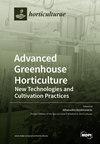Influence of Culture Conditions on Growth and Daidzein and Genistein Production in Hairy Root Cultures of Pueraria candollei var. mirifica
IF 3.1
3区 农林科学
Q1 HORTICULTURE
引用次数: 0
Abstract
Pueraria candollei var. mirifica produces and accumulates various phytoestrogen compounds in its tuberous roots, including daidzein and genistein. Plant cell culture methods have been established to alleviate the problems associated with producing valuable phytochemicals from natural or field-cultivated plants, and hairy root culture is one of the most promising methods for the in vitro production of plant secondary metabolites. Thus, this study aimed to produce daidzein and genistein from hairy root cultures of P. candollei var. mirifica. The influences of cultivation parameters, including the culture medium, light conditions, sugar content in the culture medium, incubation temperature, and agitation speed, on biomass and daidzein and genistein production in hairy root cultures of this medicinal plant were investigated. The results revealed that the optimal cultivation conditions for biomass and bioactive compound production were Murashige & Skoog (MS) medium, a sucrose concentration of 30 g/L, a 16/8 h light/dark photoperiod, an incubation temperature of 26 °C, and an agitation speed of 90 rpm. The highest biomass and daidzein and genistein contents achieved in this study were 17.76 g/L, 6.85 mg/g DW, and 0.96 mg/g DW, respectively. Interestingly, the daidzein and genistein contents obtained from hairy roots were approximately 45.7- and 12.0-fold greater than those obtained from normal roots, respectively, suggesting that hairy root culture is a suitable method for the sustainable production of phytoestrogen, daidzein, and genistein from this medicinal plant.培养条件对 mirifica 葛根毛根培养物的生长及 Daidzein 和 Genistein 产量的影响
葛根(Pueraria candollei var. mirifica)在其块根中产生并积累了多种植物雌激素化合物,包括大豆雌酚(daidzein)和染料木素(genistein)。植物细胞培养方法的建立缓解了从天然或田间栽培植物中生产有价值的植物化学物质的相关问题,而毛根培养是体外生产植物次生代谢物的最有前途的方法之一。因此,本研究旨在利用毛根培养物生产丹参素和染料木素。研究了培养基、光照条件、培养基中的含糖量、培养温度和搅拌速度等培养参数对该药用植物毛根培养物的生物量及双歧因子和染料木素产量的影响。结果表明,产生生物量和生物活性化合物的最佳培养条件为 Murashige & Skoog(MS)培养基、蔗糖浓度为 30 克/升、光照/黑暗周期为 16/8 小时、培养温度为 26 °C、搅拌速度为 90 转/分钟。本研究中获得的最高生物量、麦黄素和染料木素含量分别为 17.76 克/升、6.85 毫克/克(干重)和 0.96 毫克/克(干重)。有趣的是,从毛状根中获得的染料木素和染料木苷含量分别比从正常根中获得的高出约 45.7 倍和 12.0 倍,这表明毛状根培养是一种从这种药用植物中持续生产植物雌激素、染料木素和染料木苷的合适方法。
本文章由计算机程序翻译,如有差异,请以英文原文为准。
求助全文
约1分钟内获得全文
求助全文

 求助内容:
求助内容: 应助结果提醒方式:
应助结果提醒方式:


